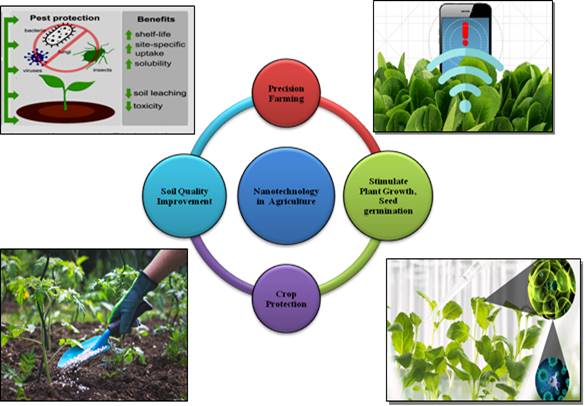
Silver Nanoparticles Agriculture: The size of silver Nanoparticles is 1nm to 100nm. Commonly used are
spherical silver Nanoparticles. Their extremely large surface area permits the coordination of a vast number of
ligands. Silver nanoparticles have long been known for their antibacterial, antifungal, anti-viral and antiinflammatory properties. The AgNP has had sufficient time to reach its target, release of the payload could be triggered by internal or external stimulus. The targeting and accumulation of nanoparticles to a designated area
ensures high drug concentration at specific sites and thus minimizes side effects. Silver Nanoparticles widely use
in a range of agriculture applications including diagnosis, target drug delivery, pest control, virus disease ,
delivery system of pest etc.
Silver Nanoparticles Agriculture
Application of silver Nanoparticles pepper anthracnose disease Silver Nanoparticles Agriculture: Anthracnose
disease, which cause by fungal pathogen Colletotrichum is a devastating disease that occurs on many
commercially important plants like bean, strawberry, perilla and other crop plants. we evaluated the effect of
silver nanoparticles against pepper anthracnose under different culture conditions. Silver nanoparticles (WA-PRWB13R) were applied at various concentrations to determine antifungal activities in vitro and in the field.The inhibition effects of silver nanoparticles against Colletotrichum species and pepper anthracnose disease in vitro
and in field trial conditions, respectively. In vitro studies deal with the effect of silver nanoparticles on
Colletotrichumspecies under different concentrations and growth medium as well as the control mechanism of
silver nanoparticles against Colletotrichumin field trials.
SILVER Nanoparticles in Agriculture and Marine Pest Control Silver Nanoparticles Agriculture: Pests are a key
antagonist against agricultural production systems. White grubs are common insect pests of sugarcane
throughout the world . Lepidiota mansueta Burmeister is a major sugarcane white grub, which causes heavy
damage to sugarcane by root invasion. The III- instar larvae of the grub damages the underground part of the
stem and root in sugarcane. This leads to the reduction of growth, and ulti-mately death.
The land snail Eobania vermiculata is an important crop pest causing considerable damage in agriculture. The
aim of the present work is to evaluate the possibilities of using silver nanoparticles (AgNPs) to control the land
snail. The AgNPs have been synthesized biologically using white radish (Raphanus sativus var. aegyptiacus). The
biosynthesis was regularly monitored by UV-Vis spectroscopy. X-ray diffraction spectra revealed peaks of
crystalline nature of AgNPs and the transmission electron micrographs further confirmed the size of the
synthesized nanoparticles ranging from 6 to 38?nm. The exposure of the snails and soil matrix to AgNPs in a
laboratory experiment reduced the activity and the viability of the land snail (20% of AgNPs treated snails died)
as well as the frequency of fungal population in the surrounding soil. Moreover histology and ultra structure
alterations have been found in both kidney and the digestive gland of AgNPs treated land snails.
SILVER Nanoparticles in Agriculture Extracellular agents produced by newly isolated bacterial strains were able
to catalyze the synthesis of silver nanoparticles (AgNPs). The most effective isolates were identified as Bacillus
pumilus, B. persicus, and Bacillus licheniformis using molecular identification. The nanoparticles, especially those
synthesized by B. licheniformis, were stable (zeta potential ranged from ?16.6 to ?21.3 mV) and showed an
excellent in vitro antimicrobial activity against important human pathogens and a considerable antiviral activity
against the Bean Yellow Mosaic Virus. The significance of the particular antiviral activity is highlighted, given the
significant yield reduction in fava bean crops resulting from Bean Yellow Mosaic Virus infections. There are very
few reports on the effectiveness of AgNPs against plant viruses.
Nanotech delivery systems for pests, nutrients and plant hormones: In the proficient use of agricultural natural
assets like water, nutrients and chemicals during precision farming, nanosensors and nano-based smart delivery
systems are user friendly. It makes the use of nanomaterials and global positioning systems with satellite
imaging of fields, farm supervisors might distantly detect crop pests or facts of stress such as drought.
Nanosensors disseminated in the field are able to sense the existence of plant viruses and the level of soil
nutrients. To put aside fertilizer consumption and to minimize environmental pollution, nanoencapsulated slow
release fertilizers have also become a style.
Silver nanoparticles in agriculture: Nanocapsules can facilitate successful incursion of herbicides through
cuticles and tissues, allowing slow and regular discharge of the active substances. This can be act as ‘magic
bullets’, containing herbicides, chemicals or genes which target exacting plant parts to liberate their substance .
Torney et al. has exploited a 3 nm mesoporous silica nanoparticle in delivering DNA and chemicals into isolated
plant cells. Mesoporous silica nanoparticle are chemically coated and act as containers for the genes delivered
into the plants, and triggers the plant to take the particles through the cell walls, where the genes are put in and
activated in a clear-cut and controlled way, without any toxic side effects. This technique firstly has been applied
to establish DNA fruitfully to tobacco and corn plants.
